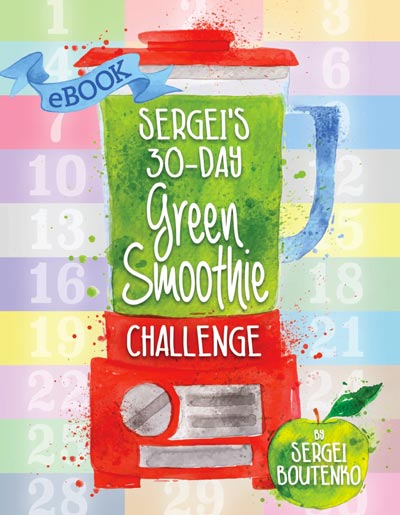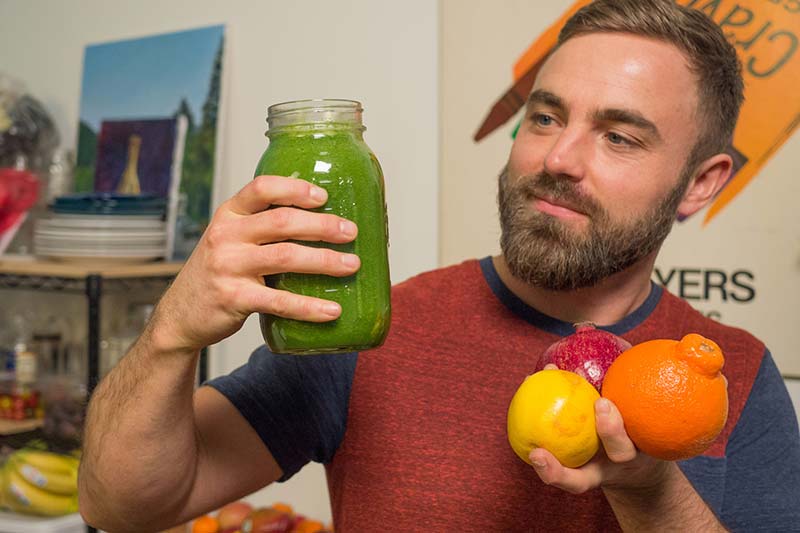Consistency & Texture
The most important component of making a tasty green smoothie is ensuring it has an even consistency and a smooth texture. To attain an even consistency, simply blend your smoothie longer. I blend my green drinks anywhere from one to two minutes in a Vitamix blender and this does the trick every time.
Pleasant texture can be a tricky thing to achieve. I meet a lot of people who say they have trouble drinking smoothies due to their undesirable texture. To ensure that your smoothies are never fibrous, frothy, or separated, it’s essential to add creamy fruit into the mix. Fruit falls into two categories: 1.) creamy fruit and 2.) pulpy fruit. If you include at least two different kinds of creamy fruits into each green drink, your smoothies will always be pleasant to drink.
Examples of Creamy Fruit
• Bananas
• Blueberries
• Apricots
• Mangoes
• Peaches
• Nectarines
• Plums
• Pears
• Strawberries
• Avocados
• Kiwis
• Dates
• Figs.
Sweetness
Sweetness is another key element of a tasty green smoothie. Especially when serving green smoothies to children or people who have never tasted them before. It is extremely important to make sure your smoothie tastes sweet and delicious. If a child tries a green smoothie for the first time and it has a bland or bitter taste, he or she will most likely never want one again. On the other hand, if you give a kid a green smoothie that tastes better than ice cream, your child will forever be hooked on this healthy habit. If you’re worried about using too much fruit in your smoothie, read my blog post titled: “Don’t Fear Fruit Sugar.”
Pulpy fruit can help in the sweetness sector. While pulpy fruits may not necessarily contribute to the texture of a smoothie, these fruits have pleasant favors and add sweetness to your concoction. Thus, if you want to ensure your smoothie is both creamy and delicious, add both types of fruit into every green drink that you make.
Examples of Pulpy Fruit
• Apples
• Melons
• Grapes
• Oranges
• Lemons
• Grapefruits
• Asian pears
• Pineapples
In the video below, my sister Valya demonstrates how creamy and pulpy fruit can save a bad-tasting smoothie.
Use Ripe Ingredients
The quality of the produce you use in your green smoothie can also define the flavor in positive or negative ways. Often, after conducting a smoothie demo, people come up to me and complain that when they follow my smoothie recipes exactly, they don’t achieve the same results. The only difference between their smoothies and mine is the quality of the ingredients.
A ripe, juicy blackberry and a sour green one are worlds apart both in flavor and nutritional value. A 2004 study of blackberries in The Journal of Agricultural Food Chemistry found that as blackberries went from under-ripe to overripe, the level of antioxidant increased from 74.7 milligrams to 317 milligrams per 100 grams. Our taste buds have known this long before modern science discovered it. Next time you’re in the store, I encourage you to choose the ripest fruit you can find and experience the enhanced nutritional benefits and decadent flavors gifted to you by nature.
If the fresh fruit you want to use in a smoothie is out of season, consider using frozen ingredients instead. In some cases, the quality of frozen fruit can be even better than fresh. This is due to the fact that frozen fruit is often harvested and packaged at peak ripeness.
Thus far, I’ve discussed the importance of blending your smoothies long enough to make them smooth, adding both sweet and pulpy fruits to the mix to make them palatable, and using ripe ingredients to maximize taste profiles. If you follow these main guidelines, your smoothies will be phenomenal! If you’d like to go above and beyond and take your green drinks to a whole new level, here are two more things to consider:
Remove Thick Stems From Your Greens
Tossing tough/bitter stems into the compost, instead of the blender, will enhance the flavor of a green smoothie. I don’t bother removing the stems of finer plants such as cilantro, parsley, lettuce, or spinach, but I do detach the stems of chard, kale, and collards. Tough stems can add a bitter or spicy flavor to your drink and can in some cases lead to indigestion.
Remove Citrus Seeds
The seeds from citrus, while entirely edible, can make a whole pitcher of smoothie turn bitter. For this reason, I always make an effort to remove the seeds from any citrus I use in my green smoothies.
Practice Makes Perfect
Finally, the best way to become a professional at any skill is to practice it. The more smoothies you blend, the better you’ll be at making green drinks that taste delicious! If you need a little help getting started, let my 30-Day Green Smoothie Challenge be your guide!

Should you need more guidance, I’ve put together an eBook, which conveniently lays out every aspect of the green smoothie challenge. I recommend saving this eBook to your favorite device so that it’s always close when you need it. For example, if you save it to your smart phone, you’ll be able to access the ingredients shopping lists and smoothie recipes at the grocery story next time you go food shopping.
Get the 41-page eBook for $15 below.



